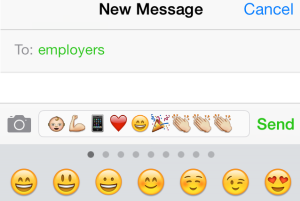Hello, my name is Samara Parker, and I am a millennial.
My generation is entering the workforce en masse; we are basically taking over your office, your break room, and your life. For this, I am sorry. I am sorry for all the #selfies we post, our love of skinny jeans, and our obsession with Portland, Oregon.
But I am not sorry for how my generation is pushing recruiting into the 21st century. It's about time! Gen Y is forcing recruiting to adopt social media strategies, optimize for mobile, and focus on employer branding. We're like that cute girl you want to date who motivates you to go to the gym, buy new shoes, and brush your teeth after eating garlicky food. What makes us so hot? Well...
Millennials are motivated by challenging work "Unlike other generations – who were simply happy with getting the job done, the younger generation need to feel like they are making a difference and that their contribution in the workplace is meaningful." - Amanda Rose
This means you can hand us all those complicated, frustrating projects you don't have time to delve into. Millennials are up for the challenge! But do make sure to provide a lot of real time positive feedback and explain how these projects benefit the company. Gen Yers respond extremely well to this kind of motivation. Social media is confusing, we can help
We've grown up with Apple products, cell phones, and big data. We understand how Facebook works, and know what Instagram filters are the coolest. And most importantly... We do what we're told!
"41% of millennials do what their managers tell them to do, which is much greater than older generations." - Dan Schawbel All we ask in return is that you use social media to recruit us. Don't make us buy a newspaper. Don't make us look on ugly old job boards! Let us apply for work from the comfort of our favorite social platform; Facebook!
83% of millennials reported using Facebook to look for work in 2013 (Jobvite). Make sure we can find you; it's surprisingly easy to set up a career section on your company Facebook Page, especially if you use a really awesome recruiting app like Jobcast.
Oh, and not to be demanding or anything, but we'd also really like it if you would make your recruiting as mobile as possible. Millennials generally prefer to look for work on our smart phones, in between exciting games of Flappy Bird. Almost 80% of us used mobile as a major part of our job search in 2013. Well... okay, maybe we are a bit demanding... 40% of us will abandon the application process if it isn't mobile-friendly #sorrynotsorry Lastly, it would be awesome if you started using more emojis in your job descriptions. Many of us have trouble understanding sentences that are not accompanied by fitting emojis. For my generation these simple graphics are what clarify the emotions behind the words. How are we supposed to know if you are being sarcastic, or if you are joking and we cannot tell because you have not included a
? It scares us. Happy social recruiting
Stay informed about all things social recruiting, sign up for our news letter!
Read More








